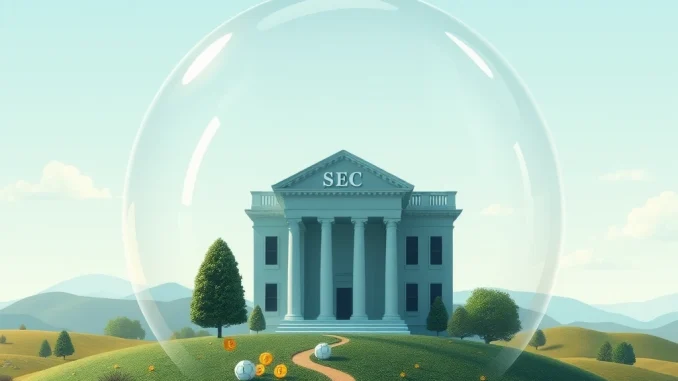
The world of digital assets is constantly evolving, and with that evolution comes the persistent question of how best to regulate it. For many in the industry, the current landscape of SEC crypto regulation feels uncertain and stifling. But a significant development has emerged from within the U.S. Securities and Exchange Commission (SEC) itself, offering a potential path forward.
Who is Hester Peirce and Why Does Her Proposal Matter for SEC Crypto Regulation?
SEC Commissioner Hester Peirce is a prominent voice within the regulatory body, often referred to as ‘Crypto Mom’ for her generally more favorable stance towards digital assets compared to some of her colleagues. She has long advocated for a more nuanced and clear approach to regulating the crypto space, recognizing its potential for innovation while also emphasizing the need for investor protection.
Her proposals carry weight because they come from a sitting commissioner, reflecting internal discussions and highlighting potential directions the SEC *could* take, even if they don’t represent the agency’s official stance yet. Her latest idea, a crypto safe harbor, is designed to bridge the gap between the current regulatory framework and the unique characteristics of decentralized networks.
Understanding the Proposed Crypto Safe Harbor
Speaking at the ‘SEC Speaks’ event, as reported by @blocknewsdotcom, Commissioner Peirce outlined her vision for a time-limited safe harbor. What does this actually mean for crypto projects?
Essentially, a safe harbor provides a temporary period during which certain activities, typically falling under strict rules, are allowed to proceed under modified or less stringent requirements, provided specific conditions are met. In this context, it would give crypto projects a window to develop and mature their networks without the immediate threat of being deemed unregistered securities offerings, assuming they follow the proposed guidelines.
Key Elements of the Proposed Crypto Rules:
Commissioner Peirce’s proposal includes several critical components aimed at balancing innovation with essential safeguards:
- Time Limit: The safe harbor would not be permanent. It would provide a defined period, likely several years, for a project to build out its network and achieve true decentralization or functionality.
- Disclosure Requirements: Projects operating under the safe harbor would need to provide clear, public disclosures about their development progress, token economics, and risks, ensuring potential participants are informed.
- Investor Protection: While providing flexibility, the framework would still include measures to protect investors, focusing on transparency and preventing fraud.
- Distinguishing Crypto Assets from Securities: A core part of the proposal is the call for clearer criteria on how to determine when a crypto asset, initially potentially sold to raise funds (like a security), transitions into something that is no longer considered a security under U.S. law (like a commodity or currency).
- Proposed Exemptions: The proposal specifically mentioned considering exemptions for certain types of crypto assets that lack typical investment contract characteristics, such as some airdrops, Non-Fungible Tokens (NFTs), and certain stablecoins.
Why is Clarity in SEC Crypto Regulation Crucial?
The current regulatory environment is often criticized for its lack of clarity. Projects are unsure whether their tokens will be deemed securities, leading to hesitation, legal costs, and sometimes, projects choosing to launch outside the U.S. This uncertainty hinders innovation and makes it difficult for legitimate businesses to operate and raise capital.
Clear crypto rules would provide a predictable framework, allowing developers, entrepreneurs, and investors to understand the expectations and requirements. A safe harbor is seen as a way to allow innovation to flourish during the critical early stages of network development, before potentially falling under full SEC purview if they retain characteristics of a security.
Potential Benefits of a Crypto Safe Harbor
Implementing a crypto safe harbor could yield several positive outcomes:
- Fostering Innovation: Provides a clearer path for decentralized networks and applications to launch and grow within the U.S.
- Retaining Talent: Encourages crypto projects to build and operate domestically rather than seeking friendlier jurisdictions abroad.
- Enhanced Investor Information: Mandated disclosures within the safe harbor period can provide more transparency to early participants than is often currently available.
- Pathway to Compliance: Gives projects a structured timeline and set of goals to meet to transition out of potential securities classification.
Challenges and the Path Forward for SEC Crypto
While Commissioner Peirce’s proposal is welcomed by many in the crypto community, it faces significant hurdles. It represents her view, not necessarily that of the SEC Chair or the majority of commissioners. Crafting effective crypto rules that are both clear and adequately protective is a complex task.
Defining the criteria for exiting the safe harbor, ensuring meaningful disclosures, and distinguishing various types of crypto assets (like differentiating an investment-focused NFT from a purely collectible one) requires careful consideration and input from various stakeholders.
The path forward involves continued dialogue, potential legislative action, and evolving regulatory interpretations. Proposals like Commissioner Peirce’s are vital steps in this ongoing conversation about how to effectively integrate digital assets into the existing financial system while acknowledging their unique nature.
Conclusion: A Glimmer of Hope for Clearer Crypto Rules
Commissioner Hester Peirce‘s proposal for a crypto safe harbor and clearer crypto rules offers a much-needed perspective on SEC crypto regulation. By suggesting a time-limited period for innovation under specific conditions, alongside calls for better definitions and targeted exemptions, she highlights a potential route towards a more predictable and supportive regulatory environment for digital assets in the U.S. While this is just a proposal and the journey to implementation is long, it represents a significant and hopeful contribution to the critical discussion around the future of SEC crypto policy.



